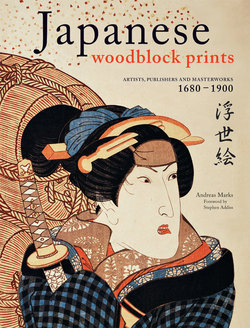Читать книгу Japanese Woodblock Prints - Andreas Marks - Страница 25
На сайте Литреса книга снята с продажи.
ОглавлениеKoryūsai
1735–1790
Family name: Isoda. Given names: Masakatsu, Shōbei. Artist name: Haruhiro.
Born 1735, Koryūsai was originally a samurai in the service of the lord of Tsuchiya. After the death of his lord he became a rōnin and settled in the Yagenbori district near Ryōgoku Bridge. He started his career as a print maker around 1769 at the age of 35 using the name Haruhiro. The fact that the first character of this name matches with the first character of Suzuki Harunobu suggests, that there was some kind of professional relation between the two. Only eight designs are known with the Haruhiro signature, showing his preference for samurai themes. He soon turned towards floating world (ukiyo) subjects and continued to work in the style of Harunobu, who had died in 1770. Koryūsai employed a wide variety of serial devices like “The Twelve Months” as in the series “Twelve Months in the Pleasure Quarters” (Enrō jūnikagetsu) of which only three designs are known, dated to c.1773–75.
In the spring of 1776, Koryūsai started the series “Models for Fashion: New Designs as Fresh Young Leaves” (Hinagata wakana no hatsumoyō), depicting courtesans from the Yoshiwara together with their attendants. the figure on the next page provides an example from this series, showing the courtesan Toyoharu and her two attendants Tasoya and Takino. He continued to produce designs for this series until 1781. Overall, Koryūsai created at least 140 different designs, making it the most extensive beauty series in the history of Japanese prints. Despite the high number of designs for “Models for Fashion,” Koryūsai simultaneously drew other prints, for example the series “Parodies of the Thirty-six Saints of Poetry in the Northern Quarter” (Hokurō yatsushi sanjūrokkasen) [Morokoshi of the Echizenya brothel].
Allen Hockley substantiated that Koryūsai adopted the “Hermit of Bukō Yagenbori” (Bukō Yagenbori inshi) signature in fall of 1778, demarcating the beginning of his life as rōnin. In 1782, when Koryūsai was 48 years old, he was honored with the Buddhist title hokkyō (lit. bridge of the law), a priestly title for artists paying tribute to their achievements. To receive this title, he had to submit a request and it seems that his good personal connections as well as his many successful flower and bird (kachō-e) designs of which roughly 170 are known, were the decisive factors for his successful bid. Koryūsai, being proud to have received this title, from now on added a reference to it to his signature. However, it seems that he significantly reduced his output after 1782 as only a small number of his prints and paintings bear this addition. Amongst them is a picture of the Six Saints of Poetry (rokkasen), copied after the painter Tosa Mitsushige (1496–1559).
Koryūsai is considered as one of the great masters of “pillar prints” (hashira-e), which became popular as decoration for Japanese homes. Over 350 designs covering various subjects were published. Koryūsai produced also an unknown number of erotica, a subject that was probably close to him because he was the leading designer of beauty prints, after the death of Harunobu in 1770. His last known print, a depiction of the famous, deified Chinese general Kan U (Chin. Guan Yu), was published by Nishimuraya Yohachi around 1790.
c.1771 Young couple and small boy feeding carp on the Drum Bridge at Kameido. Hashira-e. Library of Congress. Pins 1982, fig. 449, and Hockley 2003, appendix III, E.6.
c.1780 The courtesan Toyoharu of the Chōjiya and her two attendants Tasoya and Takino, from the series “Models for Fashion—New Designs as Fresh Young Leaves” (Hinagata wakana no hatsumoyō). ōban. Publisher: Nishimuraya Yohachi. Asian Art Museum, National Museums in Berlin. Hockley 2003, appendix II, E.110.
c.1770–72 “Clearing mist at Ichigaya” (Ichigaya no seiran), from the series “Eight Views of Edo’s Red-light Districts” (Edo irozato hakkei). Chūban. National Museum of Ethnology, Leiden, The Netherlands. Hockley 2003, appendix I, F.5-2.
mid 1780s Six Saints of Poetry (rokkasen), copied after the painter Tosa Mitsushige. Chūban. National Museum of Ethnology, Leiden, The Netherlands. Hockley 2003, appendix IV, J.7.
c.1770s Woman asleep at her desk dreams of a girl walking with a pilgrim. Chūban. Collection Peter Rieder. Hockley 2003, appendix IV, C.50.
c.1773–75 “Sixth Month” (Minazuki), from the series “Twelve Months in the Pleasure Quarters” (Enrō jūnikagetsu). Chūban. Collection Peter Rieder. Series listed in Hockley 2003, appendix I, G.9, however, not this design.
c.1776–81 The courtesan Morokoshi of the Echizenya, from the series “Parodies of the Thirty-six Saints of Poetry in the Northern Quarter” (Hokurō yatsushi sanjūrokkasen). Chūban. Collection Peter Rieder. Series listed in Hockley 2003, appendix I, O.2, however, not this design.
